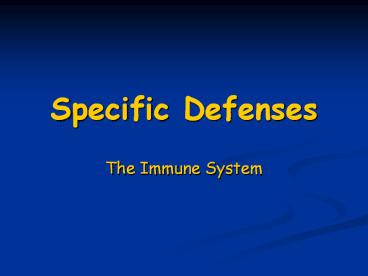Specific Defenses PowerPoint PPT Presentation
1 / 29
Title: Specific Defenses
1
Specific Defenses
- The Immune System
2
Definitions
- Innate (nonspecific) Defenses against any
pathogen - Immunity Specific antibody and lymphocyte
response to an antigen - Antigen (Ag) A substances that causes the
body to produce specific - antibodies or sensitized T cells
- Antibody (Ab) Proteins made in response to an
antigen
3
Terminology
- Serology Study of reactions between
antibodies and antigens - Antiserum Generic term for serum because it
contains Ab - Globulins Serum proteins
- Gamma (?) globulin Serum fraction containing Ab
4
Serum Proteins
Figure 17.2
5
Immunity Types
- Acquired immunity Developed during an
individual's lifetime - Humoral immunity Involves Ab produced by B
cells - Cell-mediated immunity Involves T cells
6
Acquired Immunity
- Naturally acquired active immunity
- Resulting from infection
- Naturally acquired passive immunity
- Transplacental or via colostrum
- Artificially acquired active immunity
- Injection of Ag (vaccination)
- Artificially acquired passive immunity
- Injection of Ab
7
Antigenic Determinants
- Antibodies recognize and react with antigenic
determinants or epitopes.
Figure 17.3
8
Haptens
Figure 17.4
9
Antibody Structure
Figure 17.5a-c
10
IgG antibodies
- Monomer
- 80 of serum antibodies
- Fix complement
- In blood, lymph, intestine
- Cross placenta
- Enhance phagocytosis neutralize toxins
viruses protects fetus newborn - Half-life 23 days
11
IgM antibodies
- Pentamer
- 5-10 of serum antibodies
- Fix complement
- In blood, lymph, on B cells
- Agglutinates microbes first Ab produced in
response to infection - Half-life 5 days
12
IgE antibodies
- Monomer
- 0.002 of serum antibodies
- On mast cells and basophils, in blood
- Allergic reactions lysis of parasitic worms
- Half-life 2 days
13
Clonal Selection
Figure 17.8
14
Clonal Selection
- Bone marrow gives rise to B cells.
- Mature B cells migrate to lymphoid organs.
- A mature B cells recognizes epitopes.
15
Self-tolerance
- Body doesn't make Ab against self
- Clonal deletion
- The process of destroying B and T cells that
react to self antigens
16
The Results of Ag-Ab Binding
Figure 17.9
17
Antibody titer
- Is the amount of Ab in serum
Figure 17.10
18
Monoclonal Antibodies
- Hybridomas are produced by fusing a cancer cell
with an Ab-secreting plasma cells - The hybridoma cell culture is immortal and
produces monoclonal Abs (Mabs) - Immunotoxins Mabs conjugated with a toxin to
target cancer cells - Chimeric Mabs Genetically modified mice that
produce Ab with a human constant region - Humanized Mabs Mabs that are mostly human,
except for mouse antigen-binding
19
Monoclonal Antibodies
Figure 17.11
20
Immune system cells communicate via cytokines
- Interleukin-1 Stimulates TH cells
- Interleukin-2 Activates TH, B, TC, and NK cells
- Interleukin-12 Differentiation of CD4 cells
- ?-Interferon Increase activity of
macrophages - Chemokines Cause leukocytes to move to an
infection
21
Cell-Mediated Immunity
- Specialized lymphocytes, mostly T cells, respond
to intracellular Ags - After differentiating in the thymus, T cells
migrate to lymphoid tissue - T cells differentiate into effector T cells when
stimulated by an Ag - Some effector T cells become memory cells
22
Pathogens entering the gastrointestinal or
respiratory tracts pass through
- M (microfold) cells in
- Peyer's patches which contains
- Dendritic cells which are antigen-presenting
cells and - T cells
23
Dendritic cells present antigens
Figure 17.12
24
T Cells
- Helper T Cells (CD4, TH)
- TH1 Activate cells related to cell-mediated
immunity - TH2 Activate B cells to produce eosinophils, IgM,
and IgE - Cytotoxic T Cells (CD8, TC)
- Destroy target cells with perforin
25
Helper T Cells
Figure 17.13
26
Cell-mediated Cytotoxicity
Figure 17.14
27
Nonspecific Cells
- Activated macrophages Macrophages stimulated by
ingesting Ag or by cytokines - Natural killer cells Lymphocytes that destroy
virus-infected cells, tumor
Figure 17.15
28
T-independent Antigens
Figure 17.16
29
Antibody-Dependent Cell-Mediated Cytotoxicity
Figure 17.18

